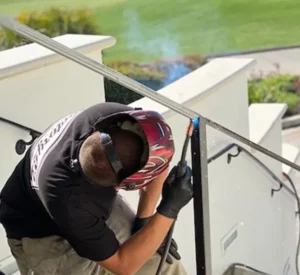Painting metal surfaces can be a challenging task, especially when it comes to removing old paint layers. Whether you’re a professional painter or a DIY enthusiast, having the right paint remover is essential for achieving optimal results. We will explore the different types of paint removers available for metal surfaces and discuss important factors to consider when choosing one. We will also delve into the science behind paint removers and provide valuable information on safety considerations, application techniques, and proper disposal practices.
Understanding Paint Removers
Paint removers are a crucial tool in the world of home improvement and restoration. Whether you’re looking to strip old paint from a metal surface or remove layers of paint from a vintage piece of furniture, understanding how paint removers work is essential. So, let’s dive into the specifics and explore the fascinating science behind these powerful chemical solutions.
The Science Behind Paint Removers
At the heart of every paint remover is a carefully formulated blend of chemicals that work together to break down paint molecules. The key ingredient in most paint removers is a strong solvent, such as methylene chloride or N-Methyl-2-pyrrolidone (NMP). These solvents have a remarkable ability to dissolve paint, making it easier to scrape or wash away.
When a paint remover is applied to a metal surface, the solvent penetrates the layers of paint, attacking the chemical bonds that hold the paint molecules together. As the solvent breaks down these bonds, the paint begins to lose its adhesion and becomes softer and more pliable. This allows for effortless removal, whether through scraping, power washing, or simply wiping away the dissolved paint.
But how does the solvent actually dissolve the paint? Well, it all comes down to the unique properties of the solvents. Methylene chloride, for example, has a low boiling point and a high vapor pressure, which means it evaporates quickly and easily. This rapid evaporation creates a cooling effect that helps break the bonds between the paint molecules, allowing the solvent to penetrate deeper into the layers of paint.
On the other hand, N-Methyl-2-pyrrolidone (NMP) is a powerful polar solvent that has a strong affinity for organic materials, such as paint. This affinity allows NMP to effectively dissolve the paint, breaking it down into smaller, more manageable particles that can be easily removed.
Safety Considerations for Using Paint Removers
While paint removers can be incredibly effective, it is important to prioritize safety when working with these chemicals. The powerful solvents and other ingredients in paint removers can pose health risks if not handled properly. Here are some key safety considerations to keep in mind:
1. Always wear protective clothing, gloves, and goggles when using paint removers. These items will shield your skin and eyes from potential splashes or fumes, reducing the risk of chemical burns or eye irritation.
2. Ensure proper ventilation in the workspace. Paint removers can release fumes that may be harmful if inhaled in high concentrations. Open windows, use fans, or work in well-ventilated areas to minimize exposure to these fumes.
3. Avoid working in confined areas without proper ventilation. The buildup of fumes in a small, enclosed space can be dangerous. If you must work in a confined area, consider using a respirator to protect your lungs from the fumes.
4. Read and follow the manufacturer’s instructions carefully. Each paint remover product may have specific guidelines for safe and effective use. Take the time to familiarize yourself with these instructions to ensure you are using the product correctly.
5. Dispose of paint remover waste properly. The chemicals in paint removers can be harmful to the environment if not disposed of correctly. Follow local regulations for hazardous waste disposal or consult with your local waste management facility for guidance.
By following these safety considerations, you can minimize the risks associated with using paint removers and ensure a safe and successful paint removal process.
Types of Paint Removers for Metal
When it comes to removing paint from metal surfaces, there are several options available on the market. Each type of paint remover has its own unique characteristics and benefits. In this article, we will explore three common types of paint removers: solvent-based removers, caustic-based removers, and biochemical removers.
Solvent-Based Removers
Solvent-based paint removers are the most common type available on the market. They typically contain a powerful solvent like methylene chloride, which effectively dissolves paint layers on metal surfaces. These removers work well on a variety of paints, including oil-based and latex-based formulations. The solvent penetrates the paint, breaking down its chemical structure and making it easier to remove.
However, it is important to note that solvent-based removers can be harsh and emit strong fumes, so proper safety precautions should be taken. It is recommended to use these removers in a well-ventilated area and wear protective gloves and goggles. Additionally, some solvent-based removers may require multiple applications or scraping to completely remove stubborn paint layers.
Caustic-Based Removers
Caustic-based paint removers, also known as alkaline removers, are another option for removing paint from metal surfaces. These removers contain alkaline substances such as sodium hydroxide or potassium hydroxide, which break down the paint chemically. Caustic-based removers are particularly effective on oil-based paints but may not be as effective on latex-based paints.
One advantage of caustic-based removers is that they can be less harsh on the skin compared to solvent-based removers. However, it is still important to take proper safety precautions and avoid direct contact with the remover. Additionally, caustic-based removers can leave a residue on the metal surface, requiring thorough rinsing to ensure a clean and paint-free finish.
Biochemical Removers
For those seeking a more eco-friendly paint removal option, biochemical removers are worth considering. These removers are made from natural ingredients such as citrus-based solvents or soy-based formulas. Biochemical removers are generally less harsh and emit fewer fumes compared to solvent-based or caustic-based removers.
One of the advantages of biochemical removers is that they are suitable for removing water-based or latex-based paints, which can be more challenging to remove with other types of removers. However, it is important to note that biochemical removers may require slightly longer dwell times compared to solvent-based or caustic-based removers. This means that the remover needs to sit on the painted surface for a longer period to effectively break down the paint.
Overall, biochemical removers offer a safer alternative for the environment and personal health. They are a great option for those who are sensitive to strong chemical odors or want to minimize their impact on the environment.
When it comes to choosing a paint remover for metal surfaces, it is important to consider the type of paint being removed, the level of effectiveness required, and the desired level of environmental friendliness. Solvent-based removers, caustic-based removers, and biochemical removers each have their own unique characteristics and benefits. By understanding the differences between these types of removers, you can make an informed decision and achieve the best results for your paint removal project.
Factors to Consider When Choosing a Paint Remover
Choosing the right paint remover is essential to ensure a successful and efficient paint removal process. There are several factors that you should consider before making a decision. Let’s explore some additional details about these factors:
Type of Metal Surface
When selecting a paint remover, it’s crucial to take into account the type of metal surface you are working with. Different metals may react differently to certain removers, and using the wrong one can potentially damage the metal. For example, copper or brass surfaces are more delicate and may require gentler removers to avoid any harm. On the other hand, steel or iron surfaces can withstand stronger removers without any issues.
It’s also important to consider the condition of the metal surface. If it is heavily rusted or corroded, you may need a paint remover that not only removes the paint but also addresses the underlying rust or corrosion.
Type of Paint to be Removed
The type of paint you want to remove plays a significant role in determining the most suitable paint remover. Different paint formulations require specific removers to effectively break down and remove the paint. For instance, oil-based paints are known for their durability and may require a stronger solvent-based remover to dissolve the paint layers effectively. On the other hand, water-based paints can often be effectively removed with a biochemical option, which is generally safer and less harsh.
Additionally, if the paint has been applied in multiple layers or has been on the surface for a long time, you may need a more potent paint remover that can penetrate through the layers and effectively lift the paint off the metal surface.
Environmental Impact
Considering the environmental impact of the paint remover is not only responsible but also crucial for the well-being of the planet and your local ecosystem. Traditional paint removers often contain harsh chemicals that can be harmful to the environment. When possible, opt for environmentally friendly options that have minimal adverse effects.
Look for paint removers that are labeled as eco-friendly or biodegradable. These removers are typically made from natural ingredients and do not release harmful fumes or toxins into the air. They are also safer to use and dispose of, reducing the risk of contamination.
Furthermore, some paint removers may have additional certifications or endorsements from environmental organizations, indicating their commitment to sustainability and eco-friendliness. Keep an eye out for these certifications when making your decision.
By considering the type of metal surface, the type of paint to be removed, and the environmental impact, you can make an informed decision when choosing a paint remover. Remember to always follow the instructions provided by the manufacturer and take necessary safety precautions when using any paint remover.
Application Techniques for Paint Removers
Paint removers are essential tools for removing unwanted paint from various surfaces, particularly metal. Whether you are working on a small project or tackling a larger surface, understanding the different application techniques can help you achieve the best results. In this article, we will explore two common methods: brush application and spray application.
Brush Application
Brush application is the most common and widely used method for applying paint removers. It offers precision and control, allowing you to target specific areas with ease. To begin, select a brush with stiff bristles that can effectively penetrate the layers of paint. This will ensure that the remover reaches all areas of the painted metal surface.
Before applying the remover, it is crucial to prepare the surface properly. Clean the metal surface thoroughly to remove any dirt, grease, or loose paint. This will ensure better adhesion and enhance the effectiveness of the remover.
Once the surface is prepared, apply an even layer of the paint remover using the brush. Work in small sections, ensuring that the remover is spread evenly. Allow the remover to dwell for the recommended time, as specified by the manufacturer. This will give the remover enough time to penetrate and break down the paint layers.
After the recommended dwell time has passed, you can begin the paint removal process. Use a scraper or a wire brush to gently remove the softened paint. Take care not to damage the underlying surface. If necessary, repeat the application process to remove any remaining paint.
Spray Application
For larger metal surfaces or difficult-to-reach areas, spray application can be a convenient option. It allows for quick and even coverage, saving you time and effort. To use this method, you will need a spray bottle or a paint sprayer specifically designed for paint removers.
Before starting, it is important to protect surrounding surfaces from overspray. Cover adjacent areas with plastic sheets or use masking tape to create a boundary. This will prevent the remover from inadvertently affecting other surfaces.
When using a spray bottle, fill it with the paint remover and adjust the nozzle to achieve the desired spray pattern. Hold the bottle at a distance from the surface and apply an even coat of the remover. Take care not to oversaturate the area, as this may lead to excessive dripping.
If you are using a paint sprayer, ensure that it is properly calibrated to deliver an even spray. Follow the manufacturer’s instructions for setting up and using the sprayer. Begin by applying the remover in a sweeping motion, covering the entire surface evenly. Remember to wear appropriate safety gear, such as goggles and a respirator, to protect yourself from inhaling the mist.
Allow the remover to dwell for the recommended time, as specified by the manufacturer. This will give it sufficient time to penetrate and loosen the paint layers. Once the dwell time has elapsed, you can proceed with the paint removal process using a scraper or a wire brush.
By understanding and utilizing these application techniques, you can effectively remove unwanted paint from metal surfaces. Whether you choose brush application for its precision or spray application for its convenience, following the recommended steps and safety precautions will ensure a successful paint removal process.
Proper Disposal of Paint Removers
Local Regulations for Disposal
Proper disposal of paint removers is essential to protect the environment and prevent harm to human health. Contact your local waste management facility or check local regulations to ensure compliance with proper disposal methods. Some areas may require specific disposal procedures.
Safe Disposal Practices
In general, sealed containers of paint remover should be taken to designated hazardous waste collection sites. Do not pour the remover down drains or dispose of it in regular trash. Follow the instructions provided by the manufacturer for safe disposal practices, which may involve transferring the remover to approved containers for disposal or recycling.
Seeking Professional Assistance
When it comes to restoring metal surfaces to their former glory, selecting the best paint remover is a crucial decision. At Smith Welding & Fabrication, we’re dedicated to helping you achieve outstanding results in your metal restoration projects. While we’re all for DIY enthusiasts tackling tasks around the house, it’s vital to stress the importance of consulting a professional welder or metal worker when dealing with intricate metal surfaces and paint removal. Removing paint from metal can be a complex process that requires specialized knowledge, techniques, and safety precautions. In this blog post, we’ll guide you through the top paint removers for metal surfaces, but we strongly caution against attempting complex metal restoration yourself without the necessary expertise. Your safety and the quality of the finished product should always be a priority. Don’t hesitate to reach out to the experts at Smith Welding & Fabrication for expert advice and assistance with your metal restoration projects.
When it comes to selecting the best paint remover for metal surfaces, consider the type of remover that suits your needs, the type of metal surface you are working with, and the environmental impact of the remover. Always prioritize safety when using paint removers and follow the manufacturer’s instructions carefully. By choosing the right paint remover and employing proper application techniques, you can achieve clean, paint-free metal surfaces with ease.
Now that you are armed with valuable information about paint removers, you can confidently tackle your next metal painting project with ease and achieve professional-quality results.







